Anyone who admires an active, colorful reef tank takes note of the different coral structures.
And you’ve probably seen one that resembles a sea anemone, either extending branches into the current or covering a back wall. That stunner is frogspawn coral (Euphyllia spp.).
Aquarists prize frogspawn coral for their two-tone color schemes, relatively easy management, and the constant view of their polyps.
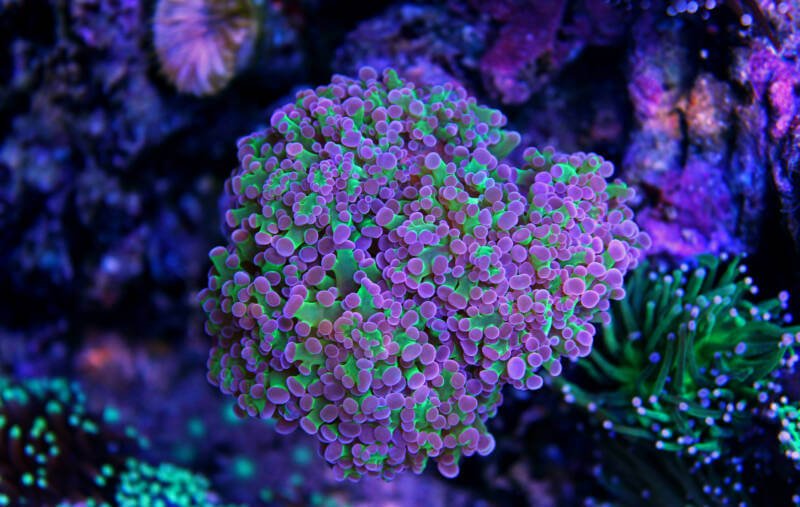
Where other coral species retract polyps at some point of the day, frogspawns remain visible all the time (provided conditions remain optimal, anyway).
As large polyp stony (LPS) corals go, they don’t present many challenges in terms of care.
You need to pay attention to their particular quirks if you want to see the colony thrive, of course, but a beginner can tackle adding this coral to their tank – with a bit of homework.
At a Glance
- Tank Size: 50 gallons (189 l)
- Temperature: 72-78F (22-25.5C)
- pH: 8.1-8.4
- Hardness: 8-12 dH
- Specific Gravity: 1.022-1.025
- Ammonia: 0 ppm
- Nitrite: 0 ppm
- Nitrate: 1-10 ppm
- Calcium: 350-450 ppm
- Magnesium: 1200-1350 ppm
- Phosphorous: 0 ppm
- Lighting: Moderate
- Water Flow: Moderate
- Size:Up to 10 inches (25 cm) wide
In this article
Appearance
Frogspawn corals get their name from the shape the clusters of polyps form.
The round lobes look like a mass of frog eggs. And as the tips of the tentacles differ from the base (usually coming in a brighter shade), they create a stunning display.
Frogspawn’s the most common name you see these LPS corals listed under, but they also appear under grape coral, honey coral, octopus coral, and wall coral.
Frogspawn corals come in a variety of colors – some easier to track down than others.
The brighter the ends of the polyps, the more neon their appearance under lower lighting schemes.
Combine it with waving tentacles in the current, and they put people in mind of sea anemones.
Types of Frogspawn Coral
You’ll find two species of frogspawn coral: branching (Euphyllia paradivisa) and wall (Euphyllia divisa).
Of course, aquarists have also hybridized the species, creating unique colors and formations between the two.
1. Branching Frogspawn (Euphyllia paradivisa)
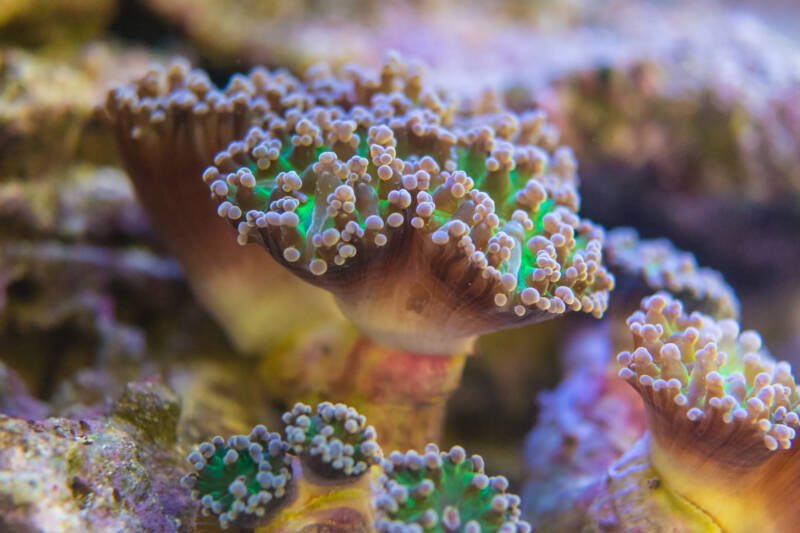
Branching frogspawn shows up the most in the hobby. You can pick them out by looking at the base of the coral.
Every polyp will emerge from its own skeleton. They grow FAST, maturing within a few months and expanding throughout a tank.
2. Wall Frogspawn Polyps (Euphyllia divisa)
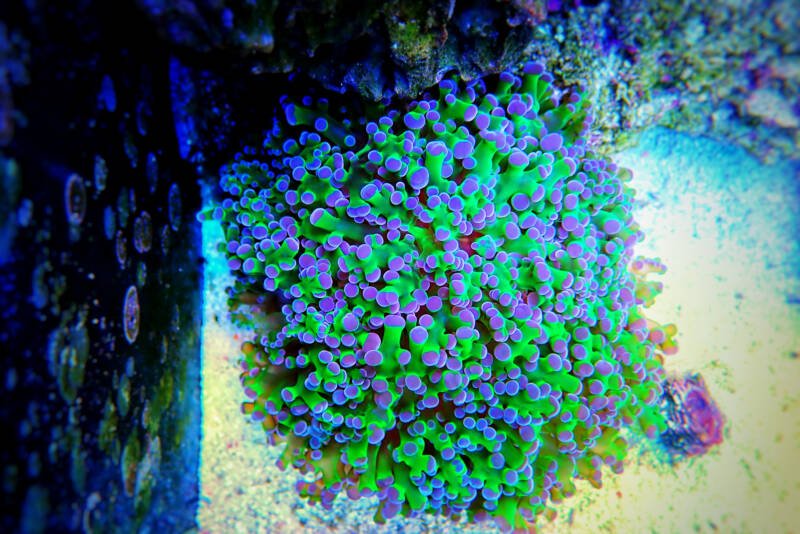
In contrast, wall frogspawn polyps share the calcium carbonate base. They don’t expand as wildly, nor do they grow as quickly.
Instead, they spread in a single direction (hence, the name “wall”). They’re a little trickier to care for, and you won’t find them as often.
In the Wild
Divers and snorkelers often come across them in Fiji, the Great Barrier Reef, the Ryukyu Islands, the Solomon Islands, and Tonga.
They build colonies of average size (compared to other LPS corals).
You won’t see frogspawns on sandy substrates. They prefer rockier slopes, anywhere between 120-140 feet (36-42 m) down.
If the water’s muddy with a touch of “muck?” They don’t mind. The organic matter provides the nutrients they feed on.
The currents in the area rank as mild, carrying additional food particles to those waiting tentacles.
And while you often spot them in bright sunlight, they’re down far enough to avoid the worst of the direct rays.
Caring for Frogspawn Coral
Frogspawn corals work nicely if you’re looking for an LPS coral to introduce you to the group.
While not precisely “easy,” they aren’t challenging to manage, either.
As long as you take your time and pay attention to their needs, you shouldn’t struggle to keep them healthy.
Tank Size
Due to the growth rate of frogspawns (even the slower wall varieties), you don’t want to go any smaller than 50 gallons (189 l).
Any tinier of a tank will prevent your coral from “stretching” and reaching its full potential. And if you plan to add other corals? It could spell disaster.
Water Conditions
The standard water conditions for a saltwater aquarium will work nicely for frogspawn corals, regardless of the variety you choose.
As their natural environment isn’t pristine, you DO have some wiggle room with your water quality – but don’t go overboard.
You still want to set up a schedule for partial water changes.
You can decide to work with a 5% change every week, a 10-15% change every other week, or a 20-25% change every month. As long as your water quality remains healthy, the choice is yours.
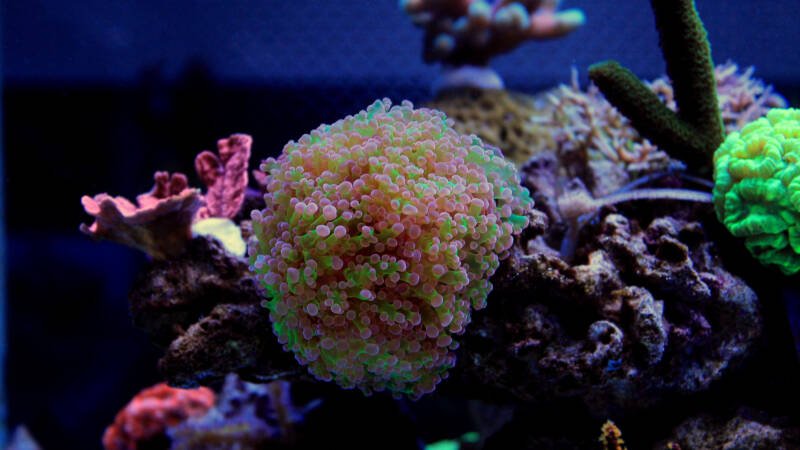
Frogspawn corals also need additional nutrients. In particular, you need to stay on top of your calcium and magnesium.
Without calcium, corals can’t grow. So you want to keep your levels around 350-450 ppm. Magnesium balances calcium, so you want that level at 1200-1350 ppm.
And then you have trace elements you can consider, such as strontium.
Frogspawn corals enjoy a strontium level around 8-10 ppm. Those routine water changes will help you maintain that level without too much trouble.
Or you can work on dosing your tank. Dosing pumps loaded with ESV B-Ionic work well (especially if you’re new to reef tanks).
You need to test your water afterward and before the next dose to check your element levels and adjust things, but your corals will appreciate it.
Lighting

Frogspawn corals appreciate – and need – a healthy light source. Without it, they’ll fail to survive and grow.
You don’t need to go overboard with your lighting, though. Unlike some LPS corals out there, frogspawns appreciate a little “filtering.”
Moderate lighting (50-150 PAR) works fine. Though, really, you want to ask about the light levels your coral frags came from.
A sudden light change will lead to stress and damage. And you CAN’T reverse the effect.
If you already have low lights in your tank, don’t despair or rush out to buy something new.
All you need to do is move your frogspawn corals a little higher in the tank. On the flip side, if your light’s PAR is too high, drop them lower.
DON’T use metal halides for frogspawn corals. They produce too much heat.
When kept under these lights, the corals will bleach or expel their zooxanthellae (the symbiotic algae in their cells). That kind of stress and damage is irreparable.
Water Flow
Similar to lighting, frogspawn corals appreciate a “middle of the road” approach to their water flow.
Setting your wavemaker to a moderate level will allow those ever-present polyps to sway in the current and remain an active part of your tank.
If the water flow is too low, the polyps draw in extra water to compensate.
They need as much surface area as possible to maximize their feeding. This results in a loss of the color you found so appealing when you purchased that coral frag.
On the flip side, if water flow goes too high, the polyps can suffer damage. To protect itself, the coral will retract its tentacles.
That means a decrease in nutrient intake, which will slow down the growth of the coral. (Or, worse, polyps may get torn by the current!)
Placement

Once you know where the “Goldilocks” zones are within your tank, you need to consider the surrounding real estate for your frogspawn coral.
As with many LPS corals, they possess sweeper tentacles. And if you’re not careful? Improper placement can lead to coral warfare.
Frogspawns possess sweeper tentacles up to six inches (15 cm) longer than their base.
At the end of each tip are nematocysts (stinging cells) capable of damaging the tissues of other corals.
If you want to keep all of your corals safe, leave a 6-8 inch (15-20 cm) buffer zone.
The exception is if you have other Euphyllia species, such as anchor or hammer corals (we’ll address torch corals in a moment).
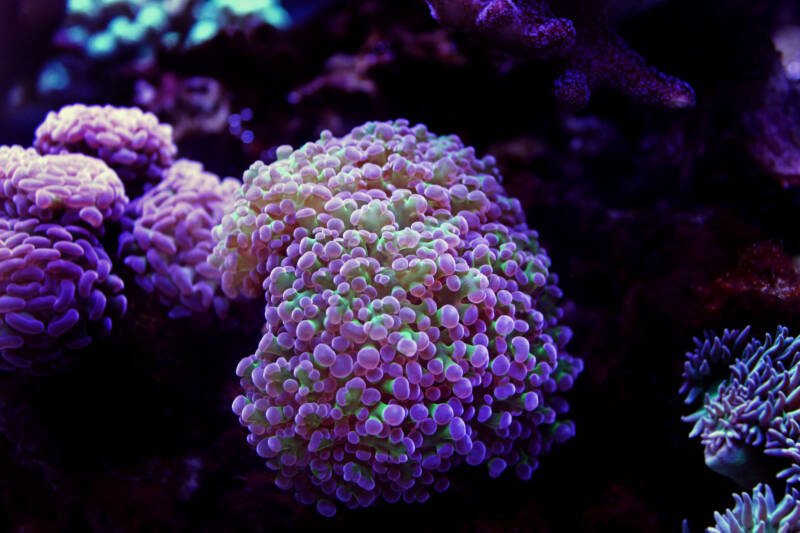
Coming from the same genus, these corals are immune to the frogspawn’s sweeper tentacles.
Finally, you don’t want to place frogspawn corals on sandy substrate.
They don’t anchor in sand in the wild, and they can collapse over the sides of their base.
This can lead to injuries to the tentacles, inviting severe health problems (that explanation will come in a minute).
The species grow along vertical surfaces in their natural habitats.
If you want to see the best growth (and health), place your frag at an angle. Even if you have a branching variety, this will yield the most success.
Frogspawn Coral Tank Mates

Corals look their best as a backdrop for a vibrant, engaging reef community.
And frogspawn corals are no exception. The polyps remain visible throughout the day and night, allowing you to craft the perfect display tank.
As long as you choose reef-safe species, your frogspawns should thrive and establish healthy colonies.
The polyps can even protect certain fish and invertebrates, knocking aside the sweeper tentacles of more aggressive corals. These species make safe tank mates:
- Anthias
- Blennies
- Cardinalfish
- Damselfish
- Gobies
- Mushroom corals
- Ricordea corals
- Sea anemones
- Tangs
- Wrasses.
On the other hand, you’ll find plenty of fish and invertebrates that find those round polyps too inviting to resist.
Whether they attempt to feed on the tentacles or decide the coral makes a perfect home, the damage wrought can lead to injury and infections. So avoid:
- Angelfish
- Butterflyfish
- Clownfish
- Emerald crabs
- Groupers
- Hermit crabs
- Parrotfish
- Puffers
- Triggerfish.
And even though they’re both Euphyllia species, you don’t want to allow torch and frogspawn corals to get too close.
Torch corals are one step higher on the aggressive ladder, and they’ll end up outcompeting your frogspawns for space.
Feeding Frogspawn Coral
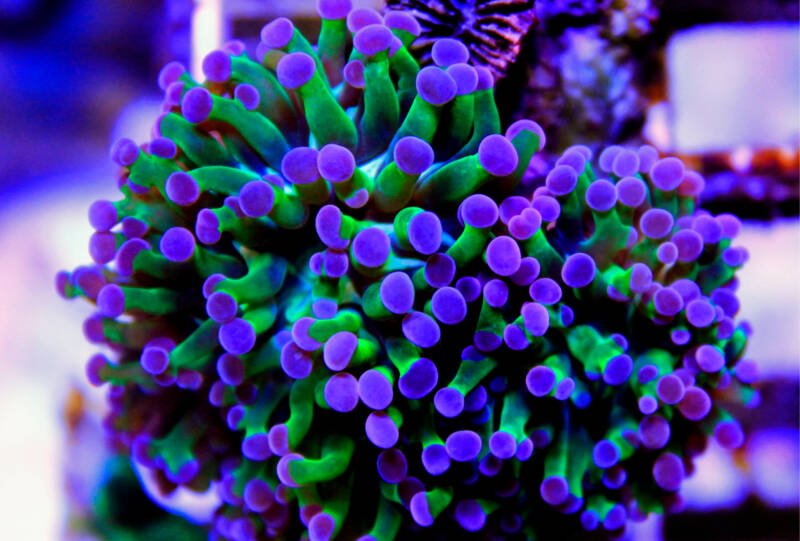
Frogspawn corals – as with other LPS corals – contain symbiotic zooxanthellae.
The algae undergo photosynthesis (hence the need for proper lighting conditions) and provide glucose (sugar) to the coral in return for a place to live.
However, the zooxanthellae don’t provide all of the nutritional needs for the coral.
As a result, they extend those polyps into the current to trap and ingest zooplankton from the current.
And if you want your corals to remain healthy? You’ll want to supplement them with food.
Frogspawn corals are relatively unique in their habit of keeping their polyps visible 24/7. During the day, the polyps extend to their full extent. At night, they retract part-way into the base.
But there’s still enough tentacle drifting in the flow to capture nutrients.
Once a week, you’ll want to target-feed or spot-feed your frogspawns.
Offering the morsels directly to the coral prevents fish and other invertebrates from stealing the meal first. You can do this with specialized devices designed precisely for feeding corals:
Types of Food
Frogspawn corals can get picky about the foods they’ll accept.
You might even see your coral spit the offering out. If so, attempt a different option the next time.
Or you may only need to cut the food into a smaller portion to make it easier for the polyp to eat.
Some aquarists insist their frogspawns enjoy commercial pellets. And Sustainable Aquatics Hatchery Diet appears to work nicely (when it DOES work). You can also stick with the more common Reef Roids.
If you choose to go with whole foods, cut up the pieces to suit the size of your frogspawn coral.
Anything too large will end up perceived as a threat, and the polyp will retract. And thaw any frozen foods BEFORE you feed them:
- Enriched brine shrimp
- Copepods
- Daphnia
- Krill
- Mysis shrimp.
Frogspawn Coral Reproduction

Frogspawn coral contains female and male gametes within the same animal.
However, they can also reproduce asexually in addition to sexual reproduction. And both of these processes go to work to grow your colonies.
Sexual reproduction doesn’t work as effectively in a tank. The gametes release from the reproductive glands simultaneously.
The fertilized egg then hatches to release a free-swimming planula larva – which usually ends up eaten before it can settle to the substrate and form a polyp.
Instead, you usually see budding. Frogspawn corals can detach groups of polyps, complete with a skeleton base.
Or they may section off a tentacle. The polyps and tentacles will then attach to a proper substrate and form a new colony.
Or you can see polyp bailout (though you don’t want to). When unfavorable environments show up, the coral undergoes apoptosis (programmed cell death).
It’s a coordinated way to cut healthy tissue away and attempt to find healthier waters.
Propagation and Fragging of Frogspawn Coral
If you want to frag your frogspawn coral, you need to first look at the variety you have.
Branching frogspawns are easier to manage and tolerate fragging better than wall varieties.
But if you’re patient (and determined), you can propagate either one.
For branching frogspawn corals, you’ll need a healthy specimen. This means solid color, plenty of visible polyps, and no damage to the colony.
Then you need a SHARP saw, your frag plug (or piece of rock), aquarium adhesive, and an iodine solution.
- Submerge your frag plugs in water for a few minutes. This will eliminate any air bubbles trapped in the ceramic and prevent them from floating.
- Using your saw, remove a few inches from your frogspawn coral.
- Treat the frag with your iodine solution to prevent any infections.
- Glue the frag to the plug (or rock). Don’t allow any exposed slime to come in contact with any of your other corals.
- Place the plug in the same water flow and lighting conditions as the parent colony. (Respect that buffer zone)
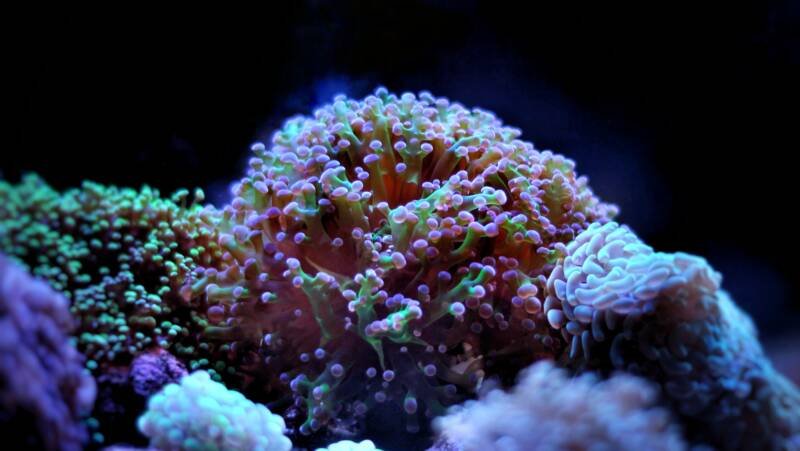
You don’t need different tools for wall frogspawn corals, but you might want a better saw.
As you need to cut through a thicker section of coral, you don’t want to cause excess damage due to a dull blade.
- Choose the section of the coral you want to cut.
- Divide the wall, cutting through the base with the saw.
- Dip the coral frag in your iodine solution to prevent infection.
- Set the frag in a low-stress area, complete with the water flow and lighting conditions you have for the parent colony.
- Monitor the frag while it heals.
- Once it begins to grow, move the frag to its new home in your tank.
Anticipated Growth Rates
Out of the Euphyllia species, frogspawn corals come out on top in terms of growth rates.
But it depends on the variety you happen to have as to how fast you can expect your frags to take off once they heal.
Dense bases – such as the wall frogspawns – require longer to form their skeletons.
You’ll probably only see around ten new polyp clusters a year. And each group needs to grow in size before they start a new one.
As for the branching varieties, they aren’t as dense in the skeleton department. You’ll see a more rapid growth rate there.
It’s reasonable to expect up to 30 (or more) new clusters in a year. Again, it depends on your specific type, but it’s why they’re MUCH easier to frag and propagate.
Frogspawn Coral Health
While frogspawn corals don’t require specialized, expert care, you must follow their specific guidelines.
If you don’t, you may find yourself struggling with common health concerns that can spell the end of your colony.
Acoel Worms
Acoel worms, or brown flatworms, often show up in tanks with excessive nutrient levels.
They LOVE the polyps of frogspawn corals, attaching to the tentacles and blocking the light. In no time, the coral ends up depleted of the nutrients provided by their zooxanthellae.
Keeping your tank clean and free of excess protein will prevent these nuisances (not to mention a thorough quarantine period).
You can also use the blue velvet nudibranch (Chelidonura varians) or wrasses for pest control.
If you already have an infestation, prepare a dip for your frogspawn corals.
Set up DECHLORINATED freshwater with the same pH and temperature as your tank. Then dip your coral into the water for 5-10 seconds. The flatworm’s too sensitive to saline changes to survive.
Brown Jelly Infections
Brown jelly infections are another plague for frogspawn corals.
Whenever an injury occurs to polyps (say, from exuberant clownfish nesting in the tentacles) or water quality deteriorates, infection moves in. Then the polyps turn to a disgusting brown jelly.
If the infection doesn’t receive treatment, it can spread to the entire colony. And it doesn’t take long to kill your coral.
As soon as you see a jelly-like brown substance on your coral, you need to act fast to save what you can.
Setting up a quarantine tank is your first step. Then you need to remove the coral from the tank and suction off the jelly.
Scrub any “sick” polyps while you’re at it. Before you add the frogspawn to quarantine, put it in an iodine dip of 15ppt.
Unfortunately, this treatment may not work. Many people recommend amputating the infected portion of the colony.
And you need to go into healthy tissue to ensure you don’t leave any pathogens behind. Then you need to monitor the coral in quarantine for recovery.
Frogspawn Coral: Are They For You?
Depending on the size of your frag, the variety you’re considering, and available colors, you can find frogspawn colors for anywhere from $50-$200.
As you go into the brighter (and more neon) color palettes, they get more expensive.
But since these particular LPS corals won’t break your bank in terms of a reef tank setup, they’re not unreasonable choices.
And their rapid growth (if you go for a branching variety, anyway) means you’ll have a healthy colony in no time.
Branching Off the Wall
With polyps waving in the current at every hour of the day and night, frogspawn corals rank at the top for popularity.
They need some respect with placement, but they’re moderate in their lighting, water flow, and management needs. And that makes them all the more appealing.
Do you have frogspawn corals? Are they branching or wall?
What’s your favorite food to use when target feeding?
Share your questions and stories with us here!